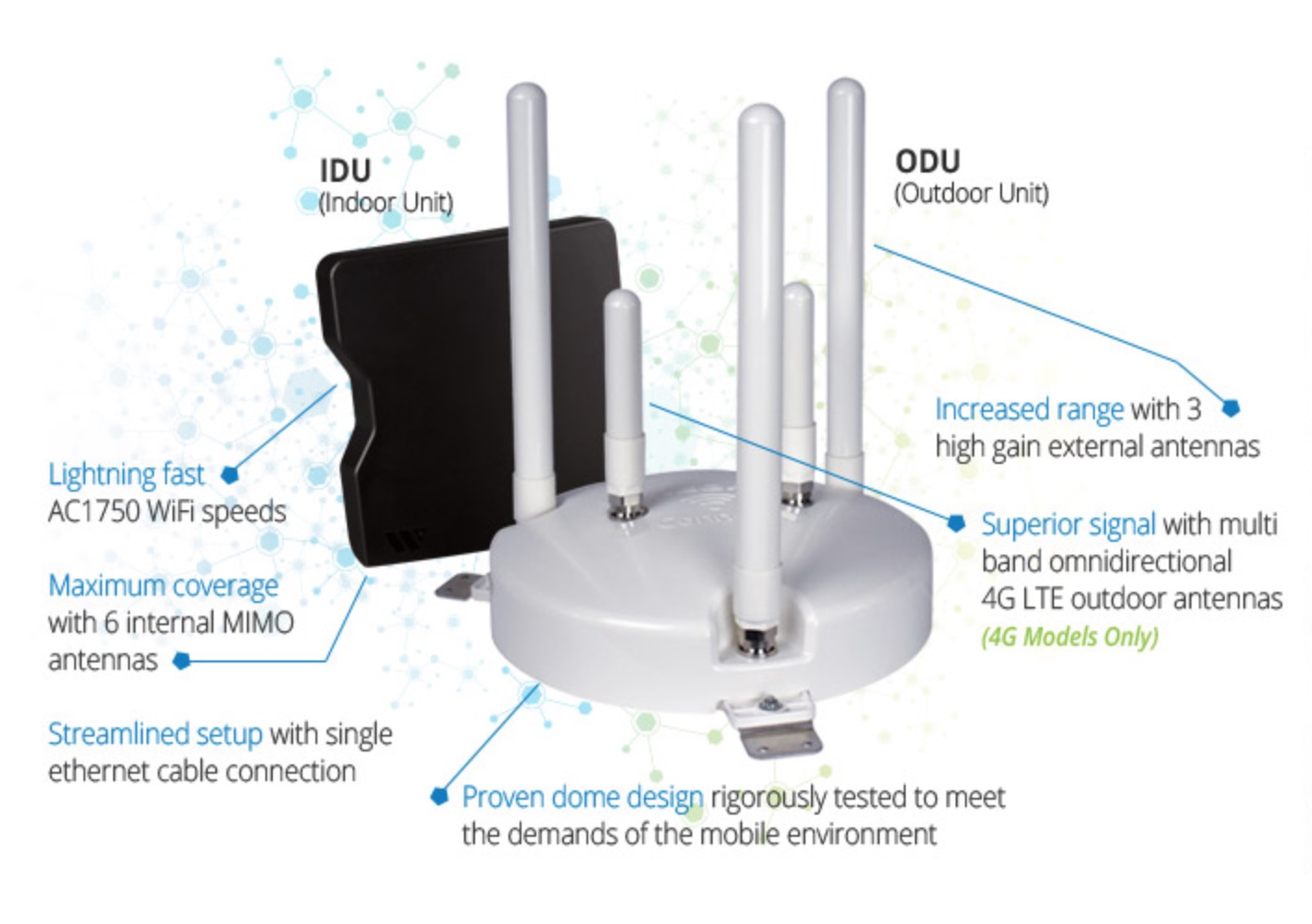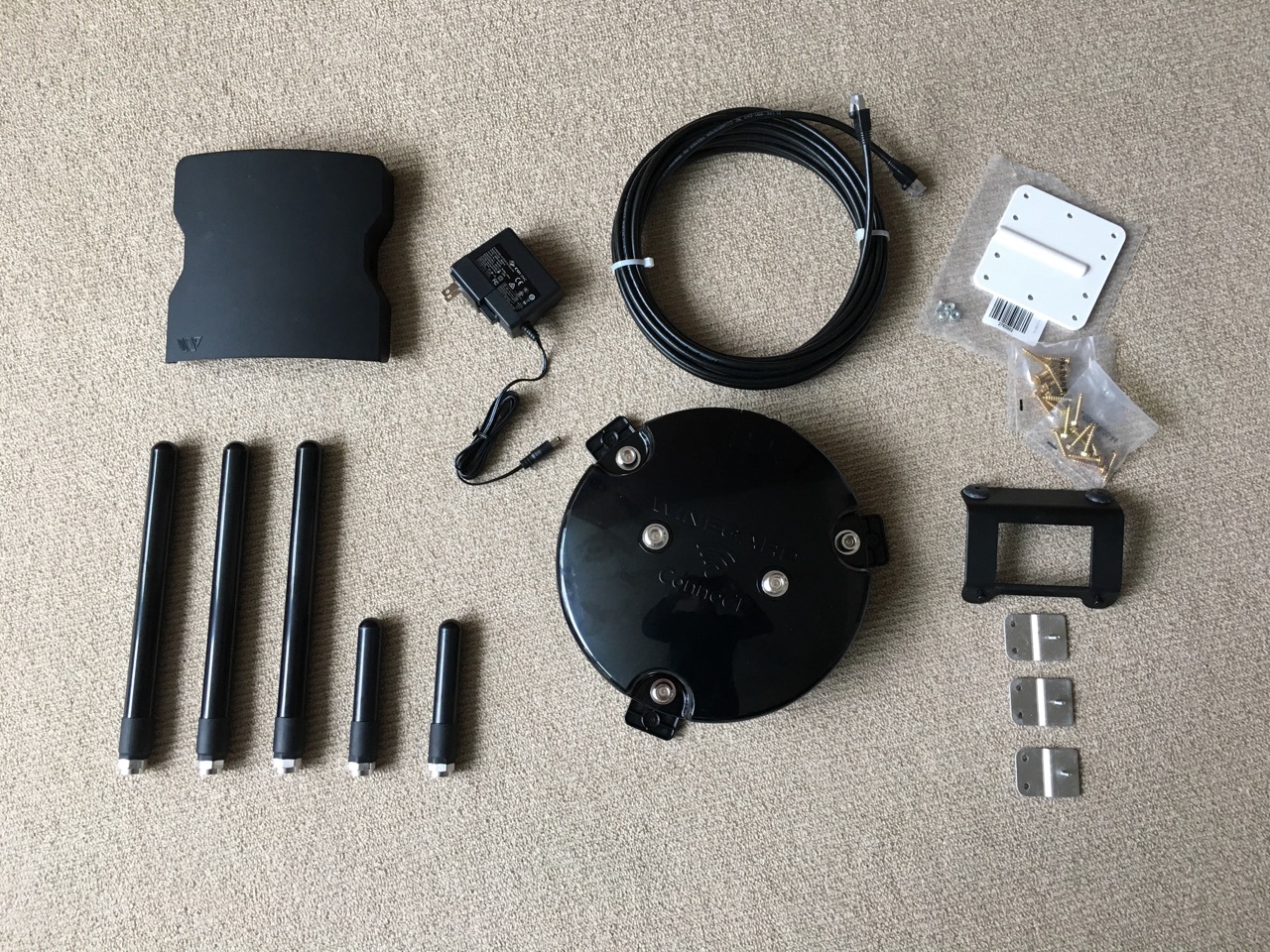
Go Gear: The Never-Ending Quest for Better Connectivity
Today, the desire for being connected in your RV is more popular than ever. And you're pretty much going to get connected one of two ways: either via a cellular or wifi signal.
On the cell side, you'll either use your phone (directly or as a hotspot for shared devices - if your phone and data plan support it) or a dedicated hotspot device (often called a mi-fi) that has its own dedicated cell connection and extra monthly cost. On the wifi side, you usually will try to connect your device to a hotspot at a coffee shop or RV park.
The more you come to depend on a data connection, the more you probably start thinking in terms of getting a good signal. In the five years that we've been traveling in our Navions, I seem to be on a parallel journey in search of good mobile bandwidth. While at home, I think nothing of web pages simply popping up on my screen or movies streaming in seconds. On the road, the information highway often can feel like Rural Route #3 - filled with potholes and blind corners.
The minute you start tangling with Internet connectivity, you step into a corner of the world that still can bedevil and perplex most everyone except the super technical. At its best, the arcane process of connecting to the Internet has been pretty well simplified by companies like Amazon for setting up an Echo device or Apple with their clean Airport routers. Taming complexity is very, very expensive and hard to do. And because it is, when you start working with niche products that are targeted to the RV market, they can feel unwieldy and frustrating.
Winegard is a mobile antenna company and I've used their satellite dish receivers for five years with consistent success. So, when I saw their upcoming wifi and cell antenna system last November at the RVIA industry show, I challenged them to "do better" than other products I had bought and tried. I'm pleased to say that they've come a lot closer to hitting the mark.
This wasn't a simple "send it to me and I'll plug it in" request. To really test the unit would require me to get the drill out and do a permanent installation onto the roof of my Navion. But would it be worth it for better connectivity?
Officially, the product is called the ConnecT 4G1. It's a unique hybrid and that is what makes it both intriguing and different than other products on the market. Atop a white or black plastic dome is a small farm of three wifi and two cellular antennas. Winegard already has a less expensive wifi-only unit with just three antennas. What makes the 4G1 so interesting is that it has a built-in 4G cellular modem. In software (more on this in a moment), you can switch between using the wifi or cellular modem for your data.
 There are two pieces to the system. One is the external antenna and the other is the internal router. They are cabled together by an Ethernet cable that passes both power and signal between the two boxes and greatly simplifies installation with one cord.
There are two pieces to the system. One is the external antenna and the other is the internal router. They are cabled together by an Ethernet cable that passes both power and signal between the two boxes and greatly simplifies installation with one cord.
 All the hardware you need is included. Everything is very easy to assemble.
All the hardware you need is included. Everything is very easy to assemble.
 Installation was very straightforward and took about an hour. After determining the proper position for the antenna, I drilled a 3/8" hole to pass the thicker Ethernet connector through. I bought a much shorter 3' Ethernet cable because I was doing a very short run and didn't need a lot of excess wire. I liberally spread Dicor sealant in and over all holes. The white square plate (supplied) covers the cable entry through the roof, which was screwed into place after a liberal coating of sealant was applied underneath the plate.
Installation was very straightforward and took about an hour. After determining the proper position for the antenna, I drilled a 3/8" hole to pass the thicker Ethernet connector through. I bought a much shorter 3' Ethernet cable because I was doing a very short run and didn't need a lot of excess wire. I liberally spread Dicor sealant in and over all holes. The white square plate (supplied) covers the cable entry through the roof, which was screwed into place after a liberal coating of sealant was applied underneath the plate.
The interior router unit can sit on a shelf, be propped up on a table or mounted to the wall. The molded case neatly covers the cable and power connection, but it also makes the status lights hard to see. Of course, most of the time the router is going to be mounted inside a cabinet, but I personally like the comfort of seeing little power and activity lights. However, this is pretty much a set-it-and-forget-it type of router box.
This system is designed to establish an Internet connection and then have all your in-rig devices connect to the net through the router. For us, that can mean six devices (2 iPhones, 2 iPads, and 2 MacBooks). You manage all of this through a web browser.
Yeah, that pesky ol' management through a browser thingy. For non-techies, this process isn't quite the 7th circle of hell, but it's definitely a couple of rings in. And it's here that Winegard, to their credit, has done a much better, albeit not perfect, job of making configuring the ConnecT fairly easy.
For the uninitiated, when you administer a device through a web browser, the actual software controlling that device is embedded inside it (firmware). Your browser is merely a viewing screen looking at controlling the internal programming. Like almost all routers, Winegard may offer improvements over time by having you download and install new operating updates in the firmware. This is pretty standard stuff in the world of routers.
Fortunately, the Winegard interface is pretty easy to understand. Like other mobile router products, the ConnecT scans for all the wifi connections it sees and reports on their signal strength and security status. Once you choose the wifi hotspot you want to connect to, you more than likely will have to enter a password to connect. This is a little confusing. But compared to other software/hardware products I've tried, it's not that bad. Furthermore, the ConnecT seemed faster at connecting to and logging into wifi hotspots than other products I've used. It also did a better job of maintaining a consistent signal link once connected to a hotspot.
This scan/login/connect process is where these kinds of devices can be very, very frustrating to use and the Winegard did a remarkably good job of removing a lot of friction from the experience. Furthermore, I could actually use my iPad for the administration tasks (though a laptop is less cumbersome). Other products I've used were next to impossible to use with an iPad. This is still a bit of weak spot, but Winegard seems committed to improving the product's capabilities and a more streamlined administrative interface would be nice.
Where the ConnecT really won me over was in a Walmart parking lot in Western Iowa. My iPad didn't see any wifi hotspots. My MacBook saw a couple of weak ones. After the ConnecT did a quick scan of the "neighborhood" twenty devices appeared. Among them was the open Walmart customer hotspot in the store a good five hundred feet away. Late in the evening, I was impressed with the overall speed of my Internet signal. In subsequent connections during various trips over the past several months, using the external antenna has made seemingly unusable RV park hot spots actually usable. And I find that there's much less muss and fuss to scanning and connecting to wifi hotspots.
 Antenna quality and signal strength can make a big difference in your data speeds. �
Antenna quality and signal strength can make a big difference in your data speeds. �
But wait! There's more! I've spent a lot of time talking about the wifi features of the ConnecT, but what makes this model really different is the built-in 4G LTE modem. Again, using a browser window to connect the router you can switch the ConnecT to attach itself to a cellular network. Winegard uses a top national carrier with uniformly good coverage for this service. It works very smoothly. Especially along Interstate highways, this is a great way to stay connected to the net while in motion (for a passenger, of course).
If you're a full-timer or power road warrior, the cell feature isn't probably for you as you most likely have a robust data plan and a separate mi-fi hotspot. However, what the ConnecT is perfect for is the seasonal traveler who wants the broader (and often faster) benefit of cellular data service. You simply can buy a bucket of data from 1GB up to 20 GB through Winegard ($20-$150). The beauty of this is there's no contract, activation fee, or monthly bill. While the cost of data is higher than having a larger data plan for your phone, it really can cost less if you simply want some degree of data service for a big trip or small ones throughout the year. And with the two optimized antennas on the roof, you'll also get a much better data signal than you will through your phone.
For heavy data users, like me, the perfect product would be a ConnecT with a dedicated cell modem that would replace my current hotspot and have the benefit of sucking down a better signal with the outside antennas. That currently costs me $20 a month as an extra device on my AT&T unlimited data plan. When traveling, we tend to consume nearly 1 GB of data a day, so a carrier data plan is much more cost effective than a pay-as-you go plan. Like many RV power data users, I also have a Verizon hotspot on a lower data size plan for those times I can't get an AT&T signal.
I know from experience with my satellite antennas, that Winegard's quality and technical support are excellent and the same holds true of the ConnecT wifi and wifi/4G LTE units. The software administration and relative ease of connection to a signal is a solid step forward in user experience. If mobile data connectivity is important to you, then the ConnecT products should be at the top of your list for consideration.
Comments
Comments on this post are moderated, so they will not appear instantly. All relevant questions and helpful notes are welcome! If you have a service inquiry or question related to your RV, please reach out to the customer care team directly using the phone numbers or contact form on this page .